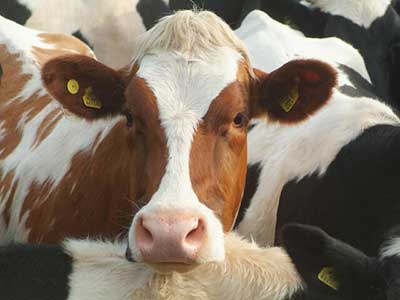Date: 10/04/2023
Relevance: GS-3: Food processing and related industries in India- scope.
Key Phrases: Fodder Inflation and Supply Constraints, Rashtriya Gokul Mission, Pradhan Mantri Matsya Sampada Yojana, Lumpy Skin Disease.
Context:
- India is faced with a milk shortage. The Centre has reportedly been considering the import of butter and ghee.
Key Highlights:
- Fodder and feed account for 70 percent of the cost of milk, with fodder development not finding much of a place in animal husbandry budgets.
- The Union Animal Husbandry Secretary recently said that cooperatives reported a milk production increase of 1-2 percent in 2022-23, while the data from other players in the organised and unorganised sector point to stagnant output.
- The dairy sector supports more than 80 million farmers, and it can provide a livelihood to many more small and marginal farmers (120 million of them, with plots too small for viable farming).
Underlying Supply Constraints in India's Dairy Sector
- Fodder Inflation and Supply Constraints :
- Fodder and feed account for 70% of the cost of milk.
- Fodder development has not found much of a place in animal husbandry budgets.
- Fodder is grown on just 4% of farmland, leading to supply constraints.
- Demand Destruction during the Covid-19 Pandemic :
- The pandemic led to a crash in milk prices, impacting farmers' ability to invest in cattle upkeep.
- The effects of this demand destruction will linger for some time.
- Lumpy Skin Disease Outbreak :
- Lumpy skin disease has wreaked havoc on livestock, leading to losses in income and capital.
- Cooperatives' Limited Success :
- Dairy cooperatives have revolutionized dairying, but their success has not gone beyond Gujarat and Karnataka.
- Private players have taken market share by offering higher prices in a buoyant market.
- Inefficient Breeding Practices:
- Inefficient breeding practices lead to low productivity and genetic variability, ultimately reducing milk production.
- Many farmers still rely on traditional breeding practices and do not have access to modern technologies for genetic improvement.
What steps can be taken?
- Encourage private players to invest in supply chains:
- Private players in the dairy sector should be encouraged to invest in supply chains, particularly in fodder development.
- This can be done by providing incentives such as tax breaks or subsidies for investments in fodder development, as well as by creating a regulatory environment that supports private investment.
- Provide price assurance for dairy farmers:
- To ensure that dairy farmers are not subject to price volatility, policies should be implemented that provide some level of price assurance.
- This can be achieved through measures such as setting minimum support prices for milk, or by creating a system of contracts between farmers and dairy companies that guarantees a fair price for milk.
- Address the impact of Covid-19:
- To address the impact of the Covid-19 pandemic on the dairy sector, policies should be implemented that provide support to farmers who have been negatively affected.
- This can include measures such as providing financial assistance to farmers to help them invest in the upkeep of their cattle, or by creating a system of insurance to protect farmers from future price shocks.
- Combat lumpy skin disease:
- Policies should be implemented to combat lumpy skin disease, which has had a significant impact on livestock in India.
- This can be done through measures such as increasing vaccination rates, or by creating a system of compensation for farmers who lose cattle due to the disease.
- Increase investment in fodder development:
- Fodder development has been a critical factor in the supply constraints facing the dairy sector in India.
- Policies should be implemented to encourage increased investment in fodder development, such as by providing financial assistance to farmers to help them grow fodder on their land, or by creating a system of subsidies for investments in fodder development.
Initiative Taken to Promote Dairy Sector in India:
- Rashtriya Gokul Mission:
- Launched in 2014, this scheme aims to promote indigenous breeds of cattle and enhance their productivity through breed improvement, nutrition, and health management.
- The mission also supports the establishment of Gokul Grams, which are integrated cattle development centres that provide training, breeding services, and market linkage to farmers.
- National Programme for Bovine Breeding and Dairy Development (NPBBDD):
- Launched in 2014, this programme aims to increase the productivity of dairy animals by promoting scientific breeding, feed and fodder development, and animal healthcare.
- The programme also supports the establishment of bulk milk cooling units and milk processing plants.
- Pradhan Mantri Matsya Sampada Yojana (PMMSY):
- Launched in 2020, this scheme aims to promote sustainable aquaculture and fisheries development in the country.
- The scheme includes a component for dairy development, which supports the establishment of dairy processing and value-addition units in coastal areas.
Conclusion:
- The milk shortage in India is a complex issue that requires a multi-pronged approach to address.
- While demand destruction during Covid, lumpy skin disease, and fodder inflation have all contributed to the drying up of milk output, there is hope that the first two factors may be transient.
- However, fodder inflation is an endemic issue that requires urgent attention from policymakers.
- Investing in policies to address embedded supply constraints, such as fodder development, could provide a solution to this long-standing problem.
Source: The Hindu BL
Mains Question:
Q. India's dairy sector is facing a milk shortage due to various factors. Discuss the underlying supply constraints in the sector and suggest policy measures to address them. (250 Words).






















